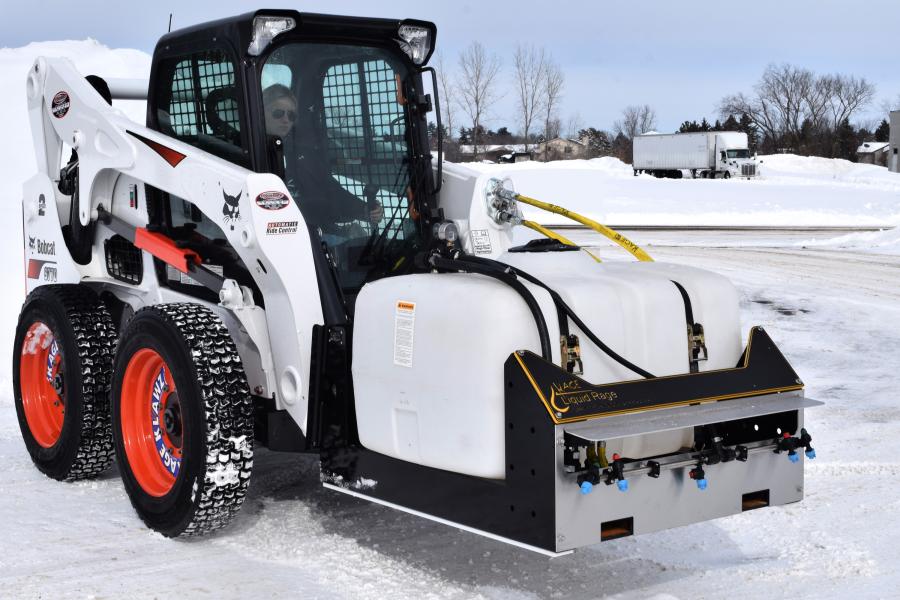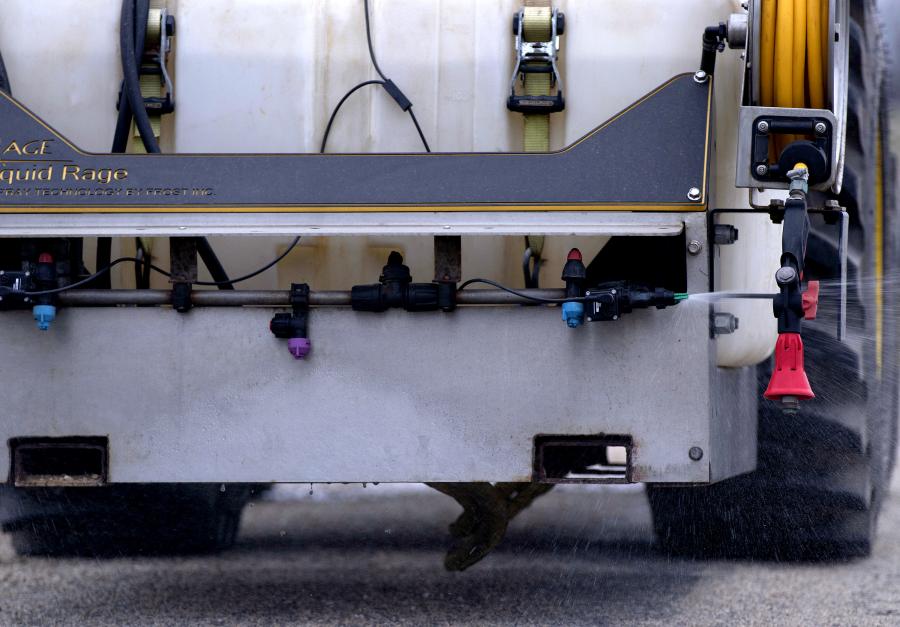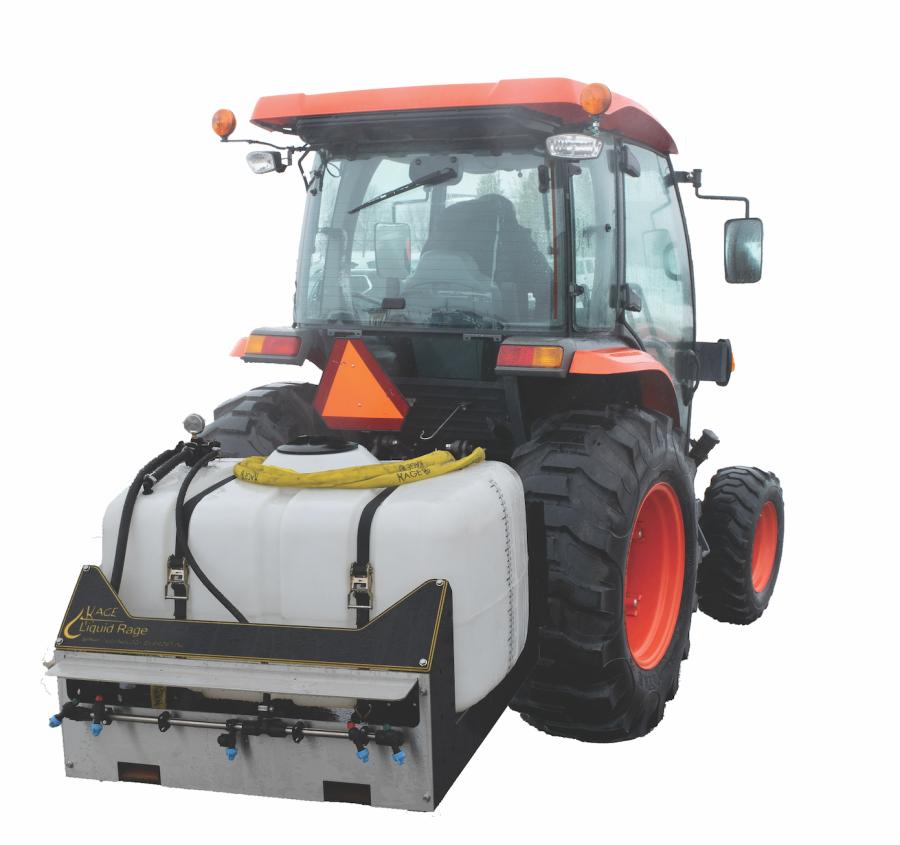KAGE Innovation offers LiquidRage, a versatile 150-gal. boomless brine sprayer designed for use with anti-ice liquids.
(KAGE Innovation photo)
If you're in the snow and ice removal industry, you've undoubtedly heard about salt brine or brine sprayers. But if you're new to the industry those terms may leaving you asking the question, "What is salt brine?"
What Is Salt Brine?
Salt brine is a term commonly used to describe an anti-icing pretreatment liquid used by commercial snow and ice removal professionals on everything from highways and city streets to sidewalks, stairs and parking lots.
Like other salt-based de-icing products, salt brine lowers the freezing temperature of water, meaning that it must get much colder outside for the rain, sleet and snow that falls onto these surfaces to freeze and adhere to the roadways or walkways. It is especially helpful in areas where ice would typically adhere fastest, such as bridges or overpasses.
That lower freezing temperature is the reason salt brine can be available in liquid form as the salt (sodium chloride) is dissolved in water to make it sprayable. At a roughly 23 percent concentration, salt brine has a freezing point of -6 F.
Sometimes beet juice is used to lower the freezing temperature of salt brine as low as -20 F, depending on the concentration.
Which Anti-Icing Chemicals Come in Liquid Brine Form?
While salt brine is the most commonly-used form of anti-icing pretreatment, due in part to its affordability, there also are numerous chemical options used by municipalities and professional snow fighters for ice control at even lower temperatures. Those include:
- Calcium Magnesium Acetate (-17.5 F freezing point at ~33 percent concentration)
- Magnesium Chloride (-28 F freezing point at ~22 percent concentration)
- Calcium Chloride (-63 F freezing point at ~30 percent concentration)
- Potassium Acetate (-76 F freezing point at ~49 percent concentration)
How to Spray Salt Brine?
Depending on the type and size of area you need to spray with salt brine you can find different kinds of sprayers with various sizes of tanks designed to work on equipment such as:
- trucks (up to 2,642 gal.)
- tow behind trailers (up to 4,035 gal.)
- tractors (up to 500 gal. on 3-point hitch)
- skid steers (up to 1,025 gal.)
- UTVs (up to 150 gal.)
- front end loaders (up to 150 gal.)
Generally liquid anti-icing sprayers deliver the liquids in two different ways — boom sprayers and boomless sprayers. Boom sprayers typically dispense the brine spraying downward to penetrate lightly covered surface while boomless sprayers dispense outward for larger coverage of snow- and ice-free surfaces.
Most brine sprayers will be able to accommodate each type of anti-icing brine but be careful if you decide to mix beet juice in with your salt brine as it can plug filters or gum up valves as it tends to be sticky in nature.
How Much Does Salt Brine Weigh?
Just because a sprayer tank can hold large quantities of brine, doesn't always mean it should. You also should take into account the weight of both the sprayer system and its contents and make sure that your carrier or machine is up to the task.
Keep in mind that salt brine, mixed at a 23 percent concentration, includes roughly 2.5 lbs. of sodium chloride and 7.5 lbs. of water per gal. of brine. This means each gallon of brine weighs 10 lbs.
To put this in perspective, KAGE has put together a quick guide below for reference on the brine weight you should expect at different quantities.
- 50 gal. of salt brine = 500 lbs.
- 100 gal. = 1,000 lbs.
- 150 gal. = 1,500 lbs.
- 250 gal. = 2,500 lbs.
- 500 gal. = 5,000 lbs.
- 1,000 gal. = 10,000 lbs.
- 2,000 gal. = 20,000 lbs.
- 4,000 gal. = 40,000 lbs.
Be sure to check how much weight your machine is designed to handle.
When Should Anti-Icing Brine Be Applied?
Salt brine should be applied up to 48 hours before a winter storm to prevent ice and snow build up. It also can be used to prevent frost and black ice for up to three days.
Calcium magnesium acetate should be applied just before or within the first couple hours of a storm. Some companies selling this type of de-icer claim it lasts three times as long as other anti-icing chemicals.
Magnesium chloride should be applied during snowstorms while the roads or other surfaces are wet.
Calcium chloride should be applied up to 48 hours before heavy snow and works well with rock salt that is often applied during and after snowstorms.
Like most pre-treatment brines, potassium acetate should be applied up to 48 hours in advance of a storm.
Liquid ice melt pretreatments lose effectiveness after 72 hours and can wash away or wear away. If it is applied more than 48 hours in advance of a storm, it's best to re-apply. If the storm has passed, plowing has taken place and another storm is moving in, it's also best to re-apply to maximize the effectiveness of its ice-repelling superpower.
LiquidRage Brine Sprayer
KAGE Innovation offers a versatile 150-gal. boomless brine sprayer designed for use with all the previously-mentioned anti-ice liquids (except beet juice). It can be used on everything from skid steers to tractors to front end loaders and UTVs. Its 150-gal. capacity is the largest in the front end loader and UTV sprayer market.
This ice-fighting brine sprayer offers two different types of valve kits for applying the liquids.
The standard nozzle kit sprays mostly downward to cover swaths up to 10 ft. wide and are designed to penetrate small amounts of hard-packed snow.
The broadcast nozzle kit offers the ability to spray farther to the side on either side of the tank — or both sides, giving up to a 30-ft. wide swath option. These nozzles work best when applying to already clear asphalt.
(This article was reprinted with the permission of KAGE Innovation. https://kageinnovation.com/comparing-brine-sprayers-anti-icing-liquids/)
Today's top stories

















